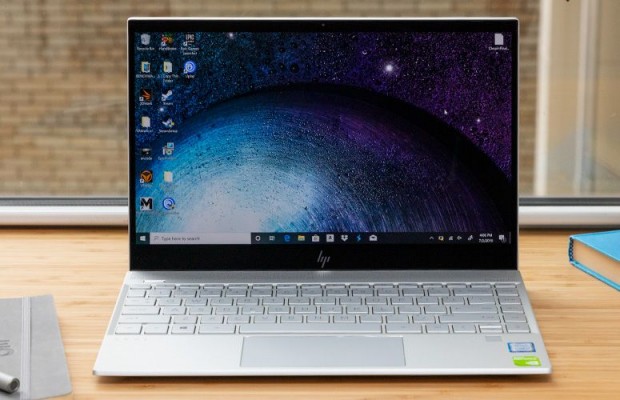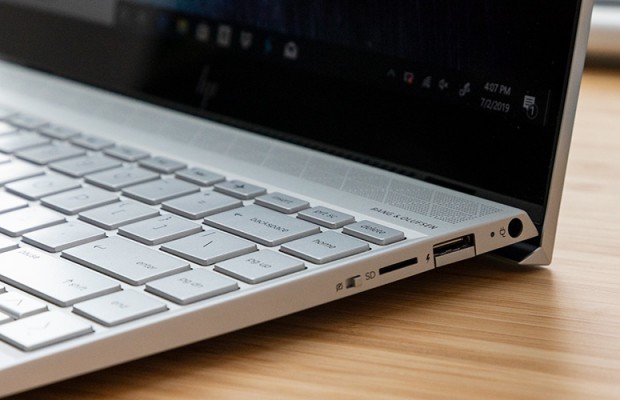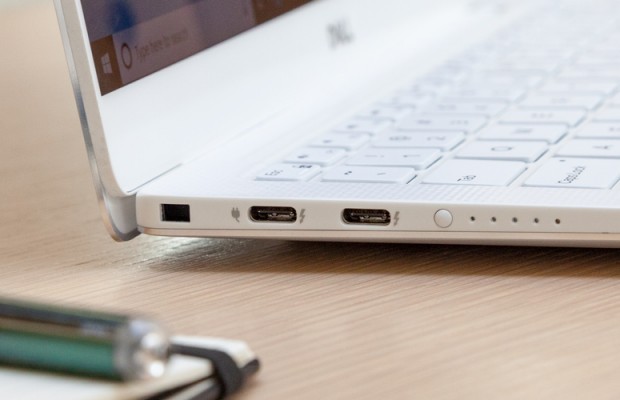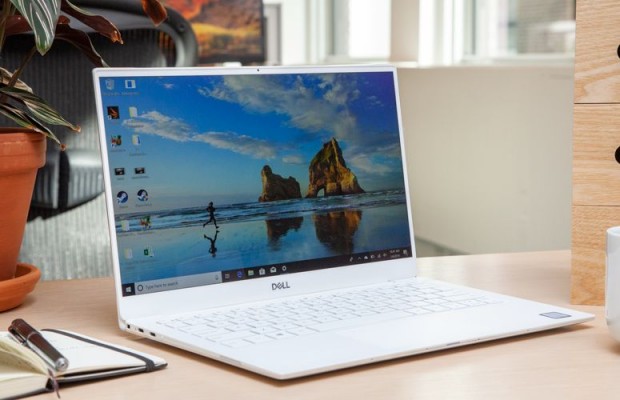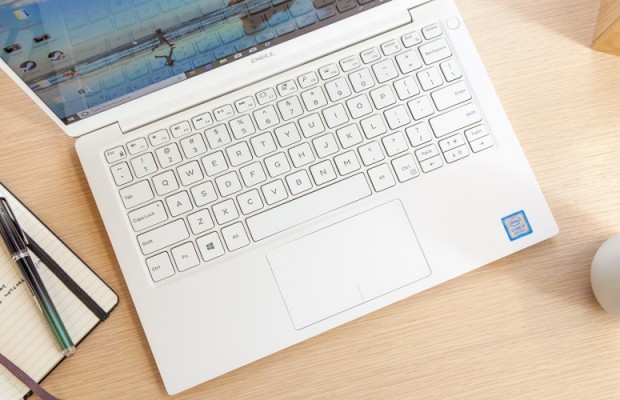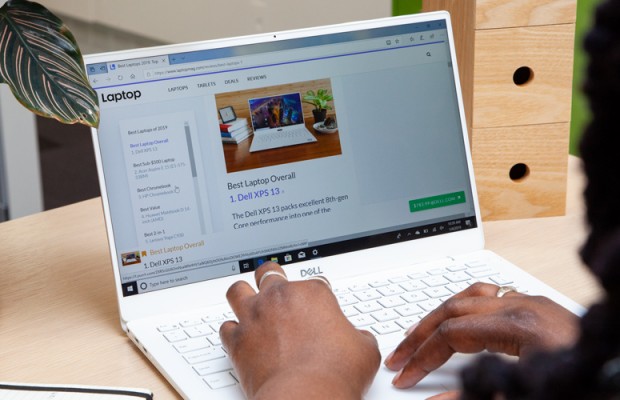HP Envy 13 vs. Dell XPS 13: Which 13-inch Laptop Is Best?
HP is on a mission to dethrone Dell's XPS 13, our favorite overall laptop. With the new Envy 13, HP is giving customers a more affordable clamshell option as an alternative to Dell's 13-inch flagship laptop.
Starting at $799, the Envy 13 costs less than the XPS 13 ($899) and even offers some features you won't find on the Dell, including an optional discrete GPU, a webcam kill switch and a unique hinge that elevates the laptop's deck. But you can never count out the XPS 13, which remains one of the most compact laptops yet offers strong performance and exceptional battery life.
Which of these outstanding 13-inch clamshell laptops would we choose, and which is right for you? Read on to find out.
HP Envy 13 vs. Dell XPS 13: Specs Compared
| Row 0 - Cell 0 | HP Envy 13 | Dell XPS 13 |
| Starting Price | $799 (Core i5) | $899 (Core i3) |
| Colors | Natural Silver, Pale Gold | Silver with black carbon fiber Rose gold with Arctic White |
| Display | 13.3-inch, 1080p or 4K touch | 13.3-inch, 1080p or 4K touch |
| CPU | Intel Core i5-8265U, i7-8565U | Intel Core i3-8145U, Core i5-8265U, Core i7-8565U |
| RAM | 8GB, 16GB | 4GB, 8GB, 16GB |
| Storage | 256GB, 512GB, 1TB | 128GB, 256GB, 512GB, 1TB |
| Ports | USB Type-C, microSD, 2 USB 3.1 Type-A, headphone | 2 Thunderbolt 3, USB 3.1 Type-C, microSD, lock slot, headphone |
| Size | 12.1 x 8.3 x 0.6 inches | 11.9 x 7.8 x 0.5 inches |
| Weight | 2.8 pounds | 2.7 pounds |
Design
It's clear from just a glance that these two laptops are premium machines. They're both thin, lightweight and sturdy. However, I favor the design of the XPS 13 over the Envy 13.
Sign up to receive The Snapshot, a free special dispatch from Laptop Mag, in your inbox.
The first advantage the XPS 13 has over the Envy 13 is its size. At 11.9 x 7.8 x 0.5 inches, the XPS 13 is one of the slimmest and most compact 13-inch laptops around, and a good deal smaller than the 12.1 x 8.3 x 0.6-inch Envy 13.
The XPS 13's size can be attributed to the razor-thin bezels that surround the laptop's display. While HP did a decent job trimming the hedges around the Envy 13's screen, the XPS 13's bezels are notably slimmer on all four sides.
And while both laptops are made of metal, you start to understand why the XPS 13 is priced higher than the Envy when you open its lid and find the deck coated in luxurious soft-touch carbon fiber (or woven glass fiber on the white model). I'm also partial to the XPS 13's two-tone black-on-silver color scheme over the singular silver color on the Envy 13.
Don't let the XPS 13's brilliant design dissuade you from the Envy 13.
I really like the hinge that lifts the deck on the Envy 13 when the laptop is open and angles the keyboard downward, creating a more comfortable typing experience. Also, the Envy 13 has some stylish contours, chrome trim and a stippled triangular pattern on its deck.
Overall, the Envy 13 has a slim, attractive design but it doesn't have the same "wow factor" as the XPS 13.
Winner: XPS 13
Ports
It's old school vs. new school.
Dell outfits the XPS 13 with multiple Thunder 3 ports, while the HP Envy 13 gives customers USB Type-A for legacy peripherals.
On the left side of the Envy 13 is a USB 3.1 Type-A port, a USB-C port, and a headphone jack, while the right side has a second USB 3.1 and a microSD card.
Two Thunderbolt 3 ports grace the left side of the XPS 13 alongside a lock slot. On the right side, you'll find a USB-C port, a microSD card slot and a headphone jack.
If you want a future-proof laptop, then go with the XPS 13. However, so many accessories and peripherals still use USB Type-A that the Envy 13's range of ports seems more useful in 2019.
Winner: Draw
Display
You can't go wrong with the 13-inch display options available on the Envy 13 and XPS 13. The 4K panels are great for content creators, like videographers and photographers. For everyone else, we recommend the 1080p models because they cost less and offer much longer battery life.
1080p display comparison
A trailer for the upcoming film The King's Man was much easier to see on the XPS 13's matte display when compared side by side with the Envy 13's glossy panel, which reflected our office's overhead lights back at me.
Otherwise, these two non-touch displays are practically identical. Fine details were equally visible on both screens — I could see intricate embroidery outlining garish ballgowns — and images were rich with saturated colors. Those fancy dresses were just slightly more vivid on the Envy 13's panel, but that's likely because of its glossy qualities.
These two 1080p displays are quite evenly matched on lab tests as well. The Envy 13's FHD panel reproduces 109% of the sRGB color gamut, which makes it slightly less vivid than the XPS 13's display (126%).
Conversely, the Envy 13 is a tad brighter than the XPS 13, peaking at 410 nits, compared with the Dell's 357 nits. Both are above the 345-nit category average.
MORE: Laptops with the Best Display Brightness
4K display comparison
If you want the best 4K display, go with the XPS 13.
I could see more subtle features on John Bernthal's face on the XPS 13's display in the trailer for Ford v Ferrari. Bernthal's skin looked overly smooth on the Envy 13's panel and his face had a sickly yellow tinge, compared with his natural dark-brown tan on the XPS 13.
The Envy 13's overly warm white balance returned on the first close-up shot of Christian Bale. I could see the actor's sunburn cheeks contrast with his pale complexion on the XPS 13, whereas his skin was oddly golden on the Envy 13's screen. Both displays get very bright, and my eyes were drawn to the saturated reds and blues of the race cars as they zipped across each panel.
Both 4K touch screens responded quickly when I tapped on their glass. I had no problems typing in URLs on either system using Windows 10's on-screen keyboard.
According to our colorimeter, the Envy 13's 4K display is brighter than the XPS 13's, at 397 nits versus 375 nits.
However, the XPS 13's UHD screen is more vivid than the Envy 13's, reproducing 119% of the sRGB color gamut, compared with the Envy's 99% coverage.
Winner: XPS 13
Keyboard and Touchpad
The Envy 13 and XPS 13 have some of the best keyboards you'll find on Ultrabooks, but for different reasons.
The keyboard on the Envy 13 is well-spaced and has big keys for those with larger hands. And with key travel of 1.2 millimeters, the keyboard isn't as shallow as those on other thin and light laptops (although it falls short of our 1.5mm preference). That said, I would prefer a lower actuation force than 81 grams and the keys have a slightly sticky feel to them.
The XPS 13's keyboard is, in some ways, opposite of the Envy 13's. People with larger hands may feel cramped, as the individual keys are shallow (1mm) and on the small side. The XPS 13's keys make up for their faults with a light, crisp clickiness and an ideal 63 grams of actuation force.
I typed at 121 words per minute with a 95% accuracy rate on the 10fastfingers.com typing test using the Envy 13's keyboard. That's a single word-per-minute faster (with the same accuracy) than my result on the XPS 13 (120 wpm, 95% accuracy).
The XPS 13's 4.1 x 2.3-inch touchpad is more comfortable to use than the Envy 13's 4.3 x 2.2-inch surface, even though the Dells touchpad is smaller. My fingers glided across the warm soft-touch coating on the XPS 13's touchpad, whereas the touchpad on the Envy 13 generated more friction. Both touchpads have Windows Precision drivers are, therefore, very responsive.
Winner: XPS 13
Performance
The performance you get out of these machines will depend on how they're configured. In general, both systems are very fast and should have no problems running demanding programs.
We tested different models of each laptop: The HP Envy with Core i7 and Core i5 CPUs and the XPS 13 with Core i7, Core i5 and Core i3 CPUs. The respective Core i7 models performed similarly. while the Core i5-equipped Envy 13 predictably topped the base XPS 13.
The Envy 13 with a Core i7-8565U CPU and 16GB of RAM scored a 15,738 on the Geekbench 4.3 overall performance test, which topped the high-end XPS 13 (14,936, Core i7-8565U/16GB of RAM) and the base model Envy 13 (15,147, Core i5-8265U/8GB of RAM). The XPS 13 with a Core i5 -8265U and 8GB of RAM fell just short of that mark (14,655) while the base XPS 13 (6,825) with a Core i3-8145U CPU and 4GB of RAM didn't get anywhere close to those results or the premium laptop average (14,910).
MORE: Laptops with the Best Productivity Performance
Both XPS 13 models crushed our video transcoding test. The Core i7 model transferred a 4K video into 1080p resolution in 19 minutes and 20 seconds, the Core i5 was even faster at 18 minutes and the Core i3 version completed the task in 20 minutes and 47 seconds. Those times are faster than the Core i7 Envy 13 (23:38), the Core i5 model (231:16) and the premium laptop average (22:27).
Both Envy 13 models are outfitted with fast storage but you'll need to pay extra for the XPS 13's high-speed SSD. The 512GB PCIe NVMe M.2 SSD inside our Core i7 Envy 13 duplicated 4.97GB of mixed-media files in 14 seconds at a rate of 364 MBps, which is slightly slower than Envy 13's optional 256GB SSD (363.5). The XPS 13 split those results, with the 1TB PCIe SSD hitting 565 MBps and the 128GB model puttering along at a sluggish 154 MBps, well short of the 761 MBps average.
The Envy 13 and XPS 13 aren't meant for gaming but if you play casual games, then go with the HP. That's because the Envy 13 has an optional GeForce MX250 discrete GPU, which scored a 116,575 on the 3DMark Ice Storm Unlimited graphics benchmark, a result that puts the integrated UHD 620 graphics in the base Envy 13 (82,270), base XPS 13 (44,394), Core i5 XPS 13 (81,148) and Core i7 XPS 13 (88,473) to shame.
Overall, we give the nod to the Envy 13 for its discrete graphics and slightly better Core i7 scores.
Winner: Envy 13
Battery Life
If battery life is a primary concern, get the 1080p XPS 13 with a Core i3 CPU, which endured for an outstanding 12 hours and 22 minutes on our battery life test (continuous web surfing over Wi-Fi at 150 nits). The more powerful Envy 13 with an FHD display and Core i5 processor put up a serious fight but fell about an hour short, at 11 hours and 11 minutes while the similarly-specced XPS 13 (Core i5/8GB of RAM) ran for 10 hours and 10 minutes.
If you want a 4K display but still need decent battery life, then the XPS 13 is the better choice. Our 4K XPS 13 model lasted for 7 hours and 50 minutes on a charge, which is more than 3 hours longer than the 4K Envy 13's paltry runtime of 4 hours and 36 minutes.
Winner: XPS 13
Value and Price
The XPS 13 is Dell's flagship laptop, so it's not surprising that it's priced higher than HP's midrange Envy 13.
Our base Envy 13 with a Core i5 CPU, 8GB of RAM and a 256GB SSD cost just $749. At the time of writing, you could spend the same amount on a higher-end model with a Core i7 CPU, 8GB of RAM and a 256GB SSD. Upgrading to a GeForce MX250 GPU costs an extra $20 while doubling storage to 16GB brings the total price to $889. If you really want a 4K display (we strongly recommend the 1080p model), those extra pixels will cost you another $140.
The base model XPS 13 with a 1080p display, Core i3 CPU, 4GB of RAM and a 128GB starts at $899. From there, you can upgrade to an FHD model with a Core i5 CPU, 8GB of RAM and a 256GB SSD for $1,049. So there’s basically a $300 delta between similarly configured Core i5 models of the Dell XPS 13 and HP Envy 13.
MORE: Best and Worst Laptop Brands
A beefy configuration of the XPS 13 with a 4K display, Core i7 CPU, 16GB of RAM and a 512GB SSD will run you $1,549. Our exorbitantly priced review unit cost $2,449 and was armed with a Core i7 CPU, 16GB of RAM and a 1TB PCIe SSD. A similarly specced Envy 13 costs just $1,399.
Winner: Envy 13
Overall Winner: Dell XPS 13
| Row 0 - Cell 0 | HP Envy 13 | Dell XPS 13 |
| Design (10) | 8 | 10 |
| Ports (10) | 7 | 7 |
| Display (15) | 12 | 14 |
| Keyboard/Touchpad (15) | 13 | 14 |
| Performance (20) | 18 | 17 |
| Battery Life (20) | 16 | 18 |
| Value (10) | 9 | 6 |
| Overall (100) | 83 | 86 |
This was a hard-fought battle, and the Dell XPS 13 wins by a narrow margin. As Dell's flagship laptop, the XPS 13 has a more premium chassis than the midrange Envy 13 and its 1080p and 4K displays produce a better picture than those on the Envy. Battery life is another area in which the Dell XPS 13 is the undisputed king.
That said, the Envy 13 is a fantastic system in its own right, especially the FHD model, which offers 11+ hours of battery life and strong performance at a much lower cost than a similarly configured XPS 13. So the bottom line is this: Get the XPS 13 if you can afford to splurge, but the Envy 13 is a fantastic value.
Credit: Laptop Mag
Phillip Tracy is the assistant managing editor at Laptop Mag where he reviews laptops, phones and other gadgets while covering the latest industry news. After graduating with a journalism degree from the University of Texas at Austin, Phillip became a tech reporter at the Daily Dot. There, he wrote reviews for a range of gadgets and covered everything from social media trends to cybersecurity. Prior to that, he wrote for RCR Wireless News covering 5G and IoT. When he's not tinkering with devices, you can find Phillip playing video games, reading, traveling or watching soccer.


